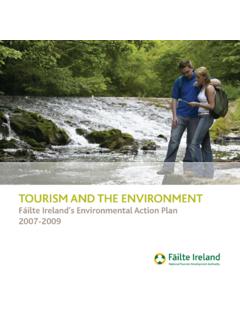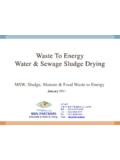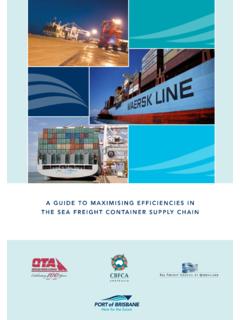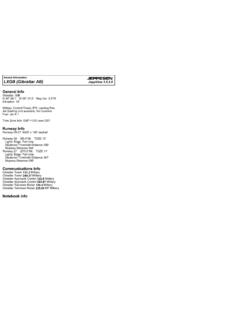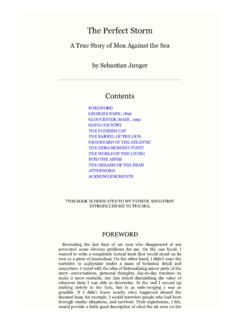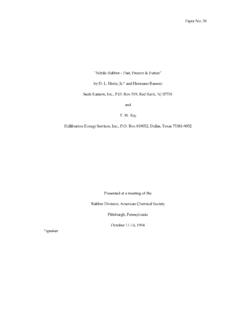Transcription of Irish Sea Creatures - Notice Nature - Home
1 Information on the environment / eolas ar an gcomhshaolWILDLIFEit s easy | to make a 40 Irish Sea CreaturesSharks ElasmobranchesIrish speciesSome people would be surprisedor maybe nervous to hear wehave sharks in Irish waters. Infact there are 10 species of sharksthat use Irish waters. Certainspecies are migratory and cometo Ireland to feed in our richwaters. These include theBasking shark, Blue shark, Short-finned Mako, Six Gilled Shark andthe Porbeagle shark. Ourresident sharks are the SpurDogfish, Greater SpottedDogfish, Lesser Spotted Dogfish,Siki Dogfish and Smooth rays are a relative of theshark family. There are many raysin Irish waters, including theThornback Ray, Blonde Ray . StingRay , Cuckoo Ray , Undulate Ray ,Homelyn Ray , Painted Ray,Electric Ray , Common Skate andWhite sharkThe basking sharks are the secondbiggest sharks in the world andare found throughout Irish seasduring the summer months. Theycan measure up to 11m in are usually seen alonecruising slowly at the surface,with dorsal fin above the waterand their mouth opened as itfilters the coastal waters for feed on tiny animals thatfloat in the water called basking shark can filter thesame amount of water found in aregular size swimming pool in onehour (about 2000 tons of water).
2 They can also be seen in largergroups from 4 to 100. It isthought that basking sharksgather in large numbers duringcourtship. At this time they areknown to leap right out of thewater, perhaps to attract a sharks come to Irelandfrom late April to late July tofeed. During these months thereare high levels of plankton inIrish waters and the sharks arefounds in certain areas wherethis food is plentiful. They disappear from the coastalsurface waters during the wintermonths. It is thought that theymove to deeper waters near theedge of the continental little is known about thesesharks migratory places to spot baskingsharks; 1) Achill Island, Co. Mayo,2) Brandon, Co. Kerry, 3) Galleyhead, Co. Cork, 4) Kinsale, , 5) Dungarvan, Co. Waterfordand 6) Hook Head, Co. Wexford Blue SharkBlue Shark measure around 2-3m. They are blue with a whiteunder belly, called countershading which helps tocamouflage themselves fromtheir prey. They have longpectoral fins that allow them toglide along ocean currents.
3 BlueShark never stop swimming; ifthey did they would sink. Theyare top predators feeding onsquid, mackerel and herring. Theyare found in coastal and offshoreIrish waters from Malin Head inDonegal, around the west andsouth coasts as far as Hook Headin Wexford. They occur mainlyduring the months of June toOctober. Irish Blue Sharksmigrate from Ireland to WestAfrica across the Atlantic Oceanthen up along the Americancoast to Canada and then back toBasking sharkBay (Co. Kerry) and use sand andmud banks to breed and haulout. Common seals can usuallybe seen individually or in groupswhen hauled out. There arenoticeable differences betweengrey and common seals;1) Size: the grey seal is bigger: greymales can reach up to 2mwhile common males can reachup to ) Face shape: the Grey seal hasan elongated muzzle while thecommon seal has a roundedfaced and tend to look ) Colouration: The colouring canbe similar but the grey seal isgenerally darker brown andgrey while the common sealhas a finer pattern of spots andtheir coat is generally lighter incolour.
4 The coat of each seal isunique. This allows photo ID tobe carried out to determinebreeding population size,residency or site ) Pups: Differences can also beseen in their pups. Grey sealsare born during September andOctober and have a white pups tend to stay with themother on the beach for thefirst three weeks. The motherfeeds them with her rich milk(seal milk is about 70% fat) andonce she leaves they have tosearch for food on their pups are born in Juneand July. The pups can swimwithin a few hours of beingborn. Early swimming enablesthem to escape from humaninterference. They come on toshore to suckle and rest. Thebond between the Commonseal and her pup is very can be seen givingpiggyback rides to early common seal will stay withtheir pup for up to 5-6 and rays have tooth-likestructures called denticles. Eachdenticle is designed to minimisedrag and become the ultimatehydrodynamic adaptation. That swhy shark s skin is rough totouch in one direction butsmooth to touch the largest threat to sharks andrays comes from the fishingindustry including incidentalcapture in fishing nets.
5 Over sixmillion blue sharks have beentaken annually from the world'soceans over the past few is also a very destructiveshark fishery in some of theworld s oceans that targets theseamazing animals just for theirdorsal fin!SealsPinnipedia (Flap footed) Irish speciesThere are two native species oftrue seals in Irish waters, the greyseal and the common (harbour) grey seal is more abundantthan common seal, and is foundthroughout the Irish breed and haul out mainlyin isolated Common (Harbour) seals arefound in more sheltered areasCarnsore Point (Co. Wexford),Clew Bay (Co. Mayo) and TraleeIreland. They are to be found inmost seas around the dogfish is our most commonshark. They are found in coastalareas, and are often seen restingon the seabed in the day. Theyhunt at night, feeding mainly oncrustaceans (crabs and shrimps),molluscs (especially whelks), andsmall fish. Dogfish use theirsense of smell to catch prey andcan also detect faint electricalfields produced by the muscles ofhidden prey.
6 During theautumn, males fertilise thefemale eggs internally. Then thefemale lays her egg capsule. Sheanchors it by swimmingrepeatedly around an object likeseaweed. Each capsule contains asingle embryo and a miniaturedogfish will emergeapproximately 9 months egg cases can then befound washed up on the beachand are know as mermaids skinIn olden days people used shark sskin to make shoe soles and sandpaper. Today, swimweardesigners are mimicking theshark s skin to create the mosthydrodynamic swimwear. One ofthe biggest problems withswimming is that a body createsdrag in the water. Sharks andrays have evolved skin thatminimises this problem. Insteadof having scales like other fish,WILDLIFE / Irish Sea Creatures / WL 40 Female Grey Sealit s easy | to make a differenceSea TurtlesThere are seven species of seaturtle in the world. They livemainly in warmer tropical , five kinds of sea turtlehave been recorded around thecoasts of Ireland. These aremigratory species that breed intropical waters and they turn uphere mainly because they havelost their way.
7 However, onespecies of turtle belongs in Irishwaters, the Leatherback Leatherback Turtle is thelargest and most wide-ranging ofall sea turtles. The biggestleatherback turtle ever recordedweighed 916 kg (approx 1 ton)found off the coast of Wales. Theleatherback is appropriatelynamed as it has a soft leathershell unlike the other sea turtleswhose shell is hard and leatherbacks are different toother living reptiles because theyare warm-blooded like birds andmammals. This enables then tofeed in colder waters like Irelandand Britain and also to dive deepto depths of 1200m. Leatherbackturtles come to Ireland during thesummer and autumn months tofeed on the abundant , like all sea turtles,are endangered. Firstly, in thetropics they are threatened attheir nesting sites. Locals eattheir eggs or kill the motherturtles for meat and coastaldevelopment interferes with theyoung hatchlings. Grown turtlesare frequently caught in fishingnets or on longline hooks, boatshit others and some may chokefrom mistaking plastic bags & WhalesCetaceansWhales and dolphins are knowncollectively as cetaceans.
8 There are24 species of cetaceans in Irishwaters. Ireland is an importanthabitat for cetaceans and in 1991,was designated as a sanctuary forwhales and are found throughoutthe Irish coast. The most familiarspecies of dolphin is thebottlenose dolphin. Shannonestuary has the largest resident(present all year round)Bottlenose population in are over 115 Bottlenosedolphins using the Shannonestuary at different times of theyear. Other species of dolphinthat are found in Ireland are theCommon dolphin, Stripeddolphin, Risso dolphin, AtlanticWhite-sided dolphin and White-beaked dolphin. Dolphins feedmainly on fish (herring, pollockand mackerel) and small cousin of the dolphin isthe harbour porpoise. They arefound in all coastal areasthroughout Ireland. They feed oncrabs, shellfish and have flat teeth (spadeteeth) to help them crush shellsand crab exoskeletons. They are ashy mammal and can be injuredInteresting facts aboutsealsSeals are believed to haveevolved from river bears 30million years ago.
9 Increasedcompetition on land drove themback towards sea hunting. Sealsare warm-blooded mammals,and have a thick layer of blubber(fat) that helps maintain theirbody temperature. On land sealslook clumsy and awkward but inthe water they are agile andcapable of moving very are a top predator feedingon mackerel, pollock andshellfish, etc. They dive to hunt,normally for 5 -15 minutes atdepths of 30 - 70 metres but candive up to 45 minutes. Sealsexhale on diving and keep theirnostrils closed during the deeper dives they have manyways to help them stay down forlonger. They can reserve theirblood supply allowingoxygenated blood only to theirheart, brain and lungs. They canalso reduce their heart rate from120 beats a minute to only 5beats a minute. Seals have arelatively large blood volume (upto twice that of terrestrialmammals).EOLAS AR AN gCOMHSHAOLSea TurtleWILDLIFE / Irish Sea Creatures / WL 40or killed by motorboats and jetskies and by fishing is one of the bestcountries in Europe to whalewatch.
10 Some of the largestwhales come to Ireland to whales such as the FinWhale measuring up to 26m inlength can be spotted off thecoast of Cork (Galley Head), Kerry(Slea Head) and Wexford (HookHead). Blue, Fin, Humpback, Sei,Minke are all baleen whales don t have teethinstead have baleen plates (comblike structure). They use theseplates to sieve water for huge mammals feed onsmall animal plankton (krill) andsmall fish (herring). Spermwhale, Pygmy Sperm whale, Killerwhale, False Killer whale,Sowerby s beaked whale,Northern bottlenose whale andLong-finned Pilot whale are alltoothed whales. Dolphins canalso be known as toothedwhales. They both have a strongset of teeth to hunt their whales form groups(pods). Unlike the baleen whales,which are usually found alone orin small knowledgeBy sharing your knowledge withothers of these majestic animalswe will increase their publicprofile. This will help us protectthese animals and ensure theirprotection in Irish list and ~ , M.
